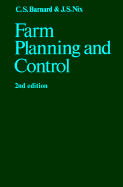Book contents
- Frontmatter
- Contents
- Notice to readers
- Preface to the first edition
- Preface to the second edition
- Selected metric conversion factors
- Part I The organisation of resources
- Part II The organisation of enterprises
- Part III The combination of enterprises
- Part IV The control of resources and enterprises
- 19 Data recording
- 20 Data analysis
- 21 Methods of control
- Selected further reading
- Index
21 - Methods of control
Published online by Cambridge University Press: 01 June 2011
- Frontmatter
- Contents
- Notice to readers
- Preface to the first edition
- Preface to the second edition
- Selected metric conversion factors
- Part I The organisation of resources
- Part II The organisation of enterprises
- Part III The combination of enterprises
- Part IV The control of resources and enterprises
- 19 Data recording
- 20 Data analysis
- 21 Methods of control
- Selected further reading
- Index
Summary
Until the 1960s, controlling the business was a neglected aspect of farm management. Yet many would argue that it is the most important part. It rather depends on how broadly the term ‘control’ is interpreted. At one extreme it might be thought of in terms of a single procedure – the annual checking of actual results against a budget forecast; on the other hand it might justifiably be held to cover every aspect of administering the farm business. In the latter case the term would encompass not only the subject-matter of the last two chapters – recording and analysis – but very much more, including all day-to-day decision-making.
It is obviously not sufficient simply to make plans and put them into operation. It is also essential to check periodically to see how the plans are progressing and whether the objectives are being achieved. Any unfavourable deviations from the charted course must be corrected as soon as possible, insofar as it is within the power of management to do so. It may be necessary to adjust the plans themselves, if changing circumstances make this appear to be desirable. The present chapter describes techniques available for this purpose.
Annual budgetary appraisal
The broadest type of performance check is to compare the actual annual financial results achieved with a budget forecast. The process of budgeting has been described in Chapter 14. The simplest form of budgetary appraisal is illustrated in Table 21.1. This consists merely of putting budgeted and actual results alongside one another and calculating the difference.
- Type
- Chapter
- Information
- Farm Planning and Control , pp. 555 - 576Publisher: Cambridge University PressPrint publication year: 1980



